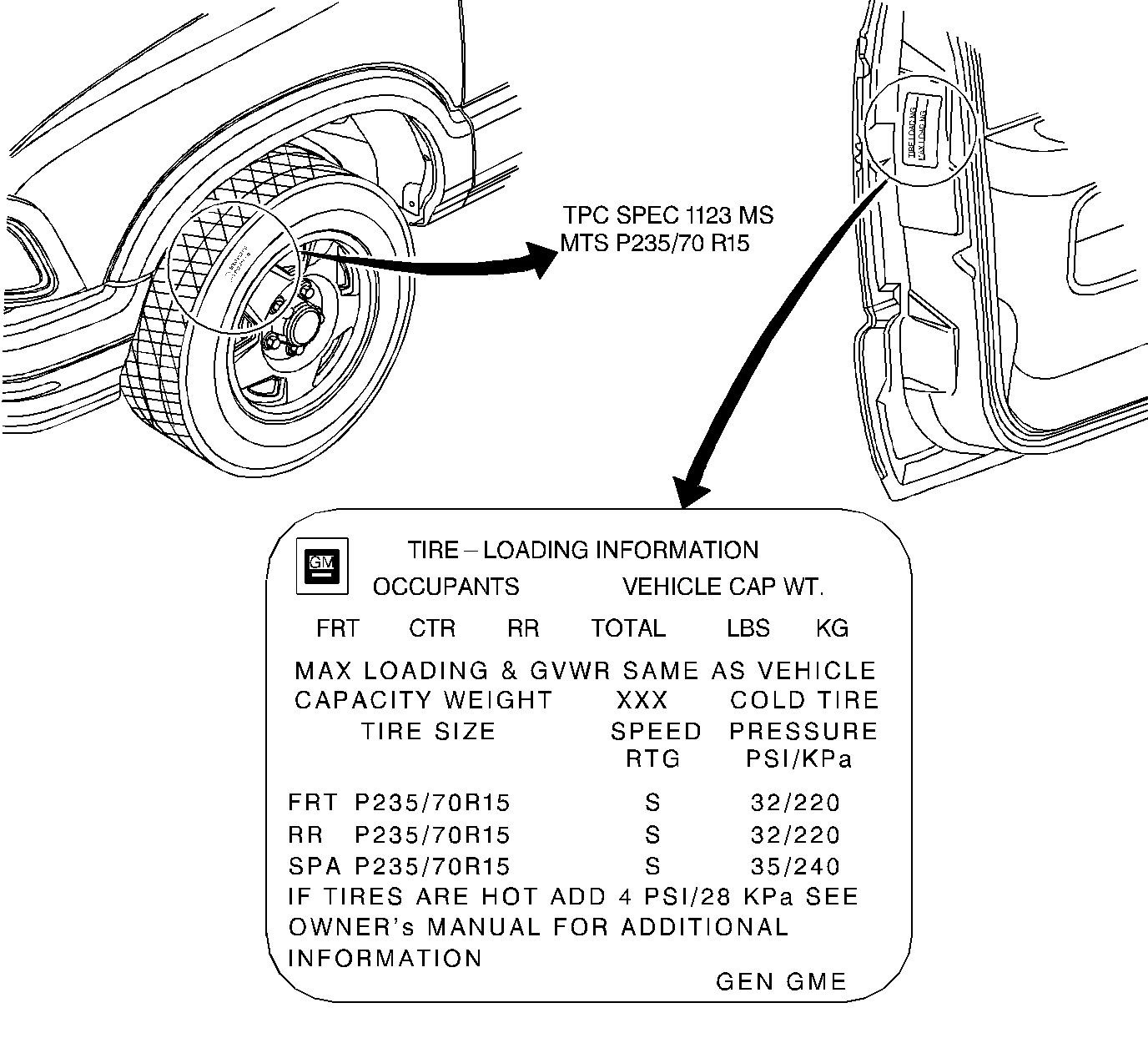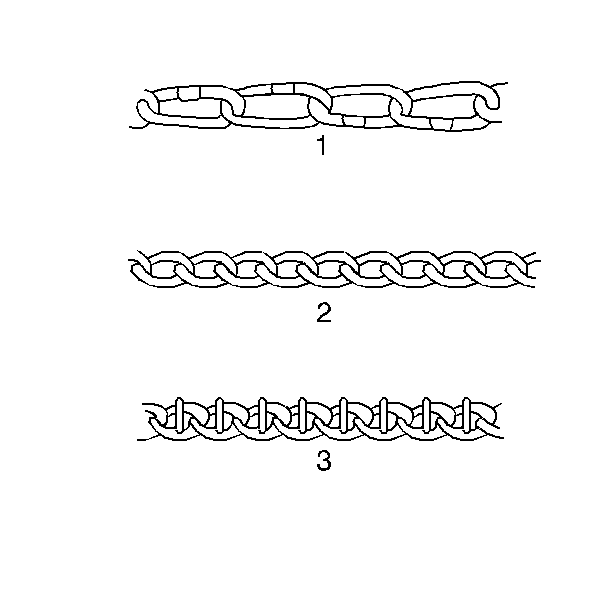
P- Metric Tires
Most P-metric tires do not have exactly corresponding alpha/numeric
tire sizes. A P235/70R15 is not equal in size and load capacity to an F78-15.
Replacement tires should be of the same TPC specification number (size, load
range, and construction) as those originally on the vehicle. If you must replace
P-metric tires with other sizes, consult a tire dealer. Tire companies can
recommend the closest match.
This is how you break down the code:
| • | MS represents Mud and Snow all-season tire. |
| • | P represents passenger car (LT for light trucks). |
| • | 235 represents the section width of the tire. |
| • | 70 represents the height to width ratio. |
| • | R represents radial construction. |
| • | 15 represents the rim diameter in inches. |
Caution: Do not mix different types of tires on the same vehicle such as radial,
bias, and bias-belted tires except in emergencies because vehicle handling
may be seriously affected and may result in loss of control and possible
serious injury.
Tire Inflation
Check the tires monthly or before any extended trip. Set the tires to
the specifications on the Tire Loading Information label. Install the valve
caps or extensions on the valves. These keep out dust and water.
The kilopascal (kPa) is the metric term for tire inflation pressure.
The tire pressure may be printed in both kilopascal (kPa) and psi. One psi
equals 6.9 kPa.
Check the tire pressure under the following conditions:
| • | When the tires are cool. |
| • | When the vehicle has not been driven for more than 3 hours. |
| • | When the vehicle has been driven less than 1.6 km (1 mi). |
When you inflate the tires to the recommended inflation pressures, the
factory-installed wheels and tires are designed to handle loads to the tire's
rated load capacity. Incorrect tire pressures, or under-inflated tires, can
cause the following conditions:
| • | Vehicle handling problems |
Correct tire pressures, wheel alignment, and driving conditions affect
tire life.
Heavy cornering, overly rapid acceleration, and heavy braking decrease
tire life.
Replacement Tires
A Tire Performance Criteria (TPC) specification number is molded in
the sidewall near the tire size of all original equipment tires. This number
ensures that the tire meets GM's performance standards for traction, endurance,
dimension, noise, handling, rolling resistance, and others. A specific TPC
number usually is assigned to each tire size.
Replacement tires should be the same size, load range, and construction
as the original tires. Replace the original tires with tires that have the
same TPC specification number. Use of any other tire size or type may seriously
affect the following items:
| • | Speedometer/odometer calibration |
| • | Vehicle ground clearance |
| • | Tire clearance to the body and chassis |
Important: Install new tires in pairs on the same axle. If you need to replace
only one tire, this should be paired with the tire that has the most tread.
Replace tires when you find the following conditions:
- The tires are worn to a point where 1.6 mm (1/16 in)
or less tread remains, or, the cord or fabric shows. The tires may have built-in
tread wear indicators that appear between the tread grooves when the tread
is 1.6 mm (1/16 in) or less. When the indicators appear in two
or more adjacent grooves at three spots around the tire, replace the tire.
- The tread or sidewall is cracked, cut, or snagged deep enough
to expose the cord or the fabric.
- The tire has a bump, bulge, or a split. Slight sidewall indentations
are normal and this should not affect ride.
- The tire has a puncture, a cut, or other damage that cannot be
repaired correctly because of the size or location of the damage.
All Season Tires
Most GM vehicles are now equipped with steel belted, all-season radial
tires as standard equipment. These tires provide a soft, quiet ride, good
handling, and long tread life. These tires provide all-season traction and
low rolling resistance in order to help improve fuel economy. These tires
have a 37 percent higher average for snow traction than non all-season radial
tires previously used. Therefore these qualify as snow tires. You can identify
these tires by an M+S molded in the tire sidewall after the size. The suffix
MS also is molded in the sidewall after the TPC specification number.
Tire Chain Usage
When you use tire chains, most current GM vehicles require the following
chain types:

| • | SAE Class S or 1100 Series, Type PL tire chains (1). |
| • | SAE Class U or 1200 Series, Type P tire chains (2). |
| • | 1800 Series Lug Reinforced tire chains (3). |
These chains are specially designed to limit the "fly off"
effect that occurs when the wheel rotates.
Manufacturers of tire chains have a specific chain size for each tire
size. These ensure a proper fit when the chains are installed. Purchase the
correct chains for the tires on which the chains will be used. Do not use
rubber adjusters to take up slack in chains that are loose due to incorrect
size. Always follow the chain manufacturer's installation instructions.
Use of chains may adversely affect handling. When using chains, remember
the following steps:
| • | Ensure that the vehicle is designed for chain clearance. |
| • | Adjust the speed to road conditions. |
| • | Avoid locked-wheel braking in order to help prevent chain damage
to the vehicle. |
| • | Install the chains as tightly as possible on the drive tires.
Tighten the chains again after driving 0.4-0.8 km (¼ -
½ mi). Do not use chains on the non-drive tires. These chains may contact
and damage the vehicle. If you use chains on the non-drive tires, ensure that
there is enough clearance. |
| • | Do not exceed 70 km/h (45 mph). Do not exceed the
chain manufacturer's speed limit, if lower. |
| • | Drive in a restrained manner. Avoid large bumps, potholes, severe
turns, and other maneuvers that cause the tires to bounce up and down. |
| • | Follow any other instructions from the chain manufacturer that
do not disagree with the above. |
Tire Loading Information Label
The tire information label is located permanently on the rear face of
the driver's door. Refer to this label. This label lists the maximum vehicle
load, the tire size (including the spare), and the cold inflation pressure
(including the spare).
Wheels
Replace the wheels if the following exist:
| • | Wheels that leak air through the welds |
| • | Wheels that have elongated bolt holes |
| • | Wheel nuts that do not stay tight |
Wheels with runout greater than specified may cause objectionable vibrations.


